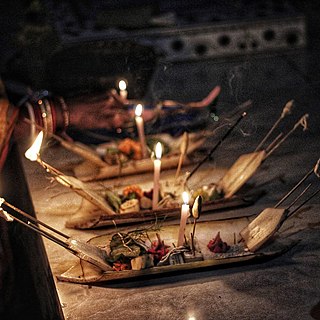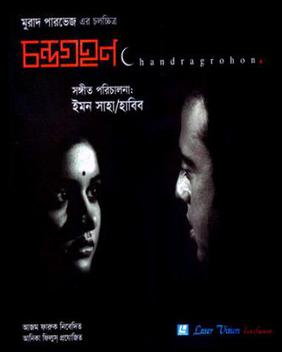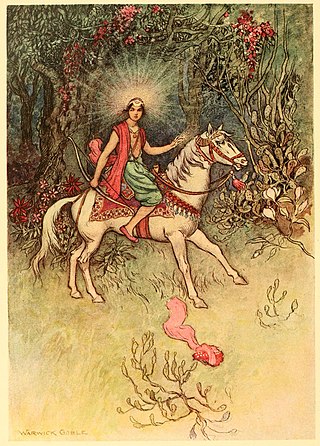
Plumeria, also known as frangipani, is a genus of flowering plants in the subfamily Rauvolfioideae, of the family Apocynaceae. Most species are deciduous shrubs or small trees. The species are native to the Neotropical realm, but are often grown as cosmopolitan ornamentals in tropical regions, especially in Hawaii, as well as hot desert climates in the Arabian Peninsula with proper irrigation.

Farida Akhtar Poppy, known by her stage name Babita, is a Bangladeshi film actress. She is best known for her performance in Satyajit Ray's Distant Thunder, a novel adaptation about the Bengal famine of 1943, which won the Golden Bear prize at the 23rd Berlin International Film Festival in 1973. She was active in the 1970s through 1990s as an actress in Bangladeshi films. She acted in 275 films.

Thakurmar Jhuli is a collection of Bengali folk tales and fairy tales. The author Dakshinaranjan Mitra Majumder collected some folktales of Bengali and published some of them under the name of "Thakurmar Jhuli" in 1907. The Nobel-Laureate, Rabindranath Tagore wrote the introduction to the anthology. Since then, it has become iconic in Bengali children's literature, becoming a household name in West Bengal and Bangladesh over the years.

The Boys with the Golden Stars is a Romanian fairy tale collected in Rumänische Märchen. Andrew Lang included it in The Violet Fairy Book. An alternate title to the tale is The Twins with the Golden Star.

Manasa is a Hindu goddess of snakes. She is worshipped mainly in Bihar, Bengal, Jharkhand, South Assam and other parts of northeastern India and in Uttarakhand, chiefly for the prevention and cure of snakebite, and also for fertility and prosperity. In Hinduism, Manasa is the sister of Shesha and Vasuki, king of Nāgas (serpents), and wife of sage Jaratkaru. She is the mother of the sage Astika. She is also known as Vishahari, Nityā (eternal) and Padmavati.
Syed Mohammad Aslam Talukder, known by his stage name Manna (মান্না), was a Bangladeshi film actor and producer.

Utsab is a 2000 Bengali-language drama film directed by Rituparno Ghosh and stars Madhabi Mukherjee, Mamata Shankar, Rituparna Sengupta, Prasenjit Chatterjee, Pradip Mukherjee, Deepankar De and Arpita Pal. The film focuses on the various emotional currents passing among family and relatives underneath the supposedly festive occasion of Durga Puja.

Bonbibi, is a legendary lady of the forest, dubbed as a guardian spirit of the forests and venerated by both the Hindu and the Muslim residents of the Sundarbans. She is called upon mostly by the honey-collectors and the woodcutters before entering the forest for protection against the attacks from the tigers. It is believed that the demon king, Dakkhin Rai, an arch-enemy of Banbibi actually appears in the disguise of a tiger and attacks human beings.
Saat Bhai Champa or Sat Bhai Chompa is a popular folk tale in the Bengal region in the eastern part of the Indian subcontinent. The story was first officially published by Dakshinaranjan Mitra Majumder in the book Thakurmar Jhuli in 1907. The introduction to Thakurmar Jhuli was written by Nobel-Laureate, Rabindranath Tagore. A more detailed version of the story was published by Bishnu Dey under the name "Sat Bhai Champa" in 1944.

Boita Bandāna also known as Dangā Bhasā, is a traditional Odia maritime and naval festival celebrated annually throughout Odisha, India. The name could be translated as "to float ritual boats and worshipping with lighted lamp" and comes from the tradition of making decorated boats, which are then floated on a river as a symbolic gesture of their ancestors' voyage.

Shashthi or Shashti is a Hindu goddess, venerated in Nepal and India as the benefactor and protector of children. She is also the deity of vegetation and reproduction and is believed to bestow children and assist during childbirth. She is often pictured as a motherly figure, riding a cat and nursing one or more infants. She is symbolically represented in a variety of forms, including an earthenware pitcher, a banyan tree or part of it or a red stone beneath such a tree; outdoor spaces termed shashthitala are also consecrated for her worship. The worship of Shashthi is prescribed to occur on the sixth day of each lunar month of the Hindu calendar as well as on the sixth day after a child's birth. Barren women desiring to conceive and mothers seeking to ensure the protection of their children will worship Shashthi and request her blessings and aid. She is especially venerated in eastern India.

Mustafa Monwar is a Bangladeshi artist. He is a painter, sculptor, radio performer and professor of fine arts. He is currently the chairman of Bangladesh Shishu Academy. He was awarded Ekushey Padak in 2004 by the Government of Bangladesh.

Chandragrohon: The Lunar Eclipse is a Bangladeshi film based on a short story written by Indian Bengali author Syed Mustafa Siraj. The film was released 2008 and younger director Murad Parvez first time directed the film. The film features Riaz, Sohana Saba, and Champa in lead roles along with Shahiduzzaman Selim, KS Firoz, Dilara Zaman, Kohinur, Gazi Rakayet, Azom Faruk and Kazi Riton in supporting roles. In 2008, the film won three National Film Awards and including other four awards.
Priyamvada Devi (1871-1935) was a Bengali writer and philanthropist.

Saat Bhai Champa was an Indian Bengali fantasy television soap opera that premiered on 27 November 2017 and aired on Zee Bangla. It is produced by Surinder Films and stars Pramita Chakraborty, Rudrajit Mukherjee and Sudipta Banerjee. The show is dubbed in Hindi as "Shoorveer sister" which airs on Big Magic channel. The Odia dubbed version is aired on Zee Sarthak. It was premiered on 27 November 2017 and aired every day at 8:00 PM on Zee Bangla. It went off air on 3 March 2019 and it got replaced by Trinayani. It is based on the folktale of Saat Bhai Champa as collected in Thakurmar Jhuli by Dakshinaranjan Mitra Majumder.

Po Rome (?–1651), also spelled Po Romê, Po Romé or Po Ramo, full name Nik Mustafa Bin Wan Abul Muzaffar Waliyullah, regnal name Sultan Abdul Hamid Shah, was the king of Panduranga Champa, reigning from 1627 to 1651.

The Boy with a Moon on his Forehead is a Bengali folktale collected by Maive Stokes and Lal Behari Day.
Champa Si Ton or Campa Si Ton is a folktale from the Lao people.
Maria is the title given to a Filipino version of Cinderella collected by Fletcher Gardner and published in The Journal of American Folklore, in 1906. The story is related both to the international Cinderella narrative, as well as to the motif of the calumniated wife.